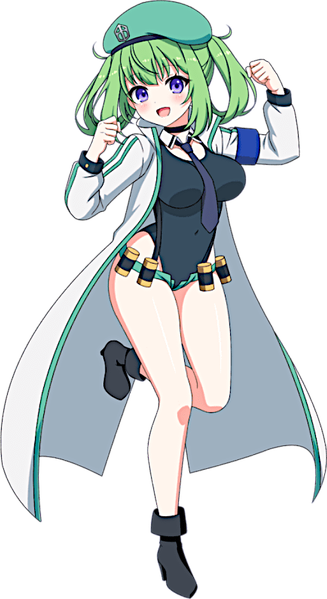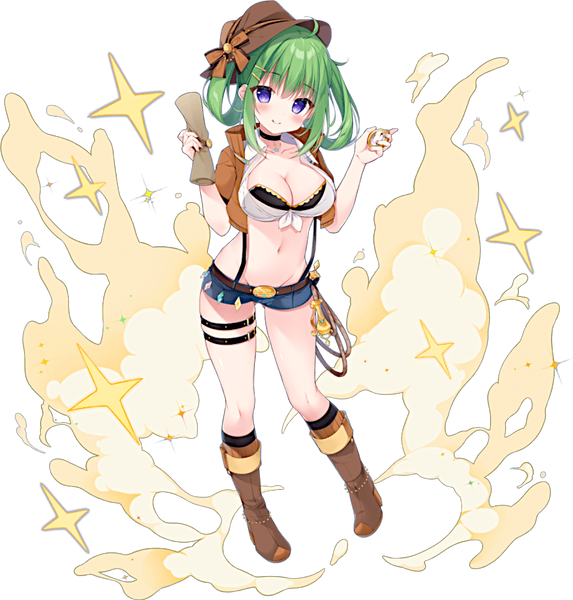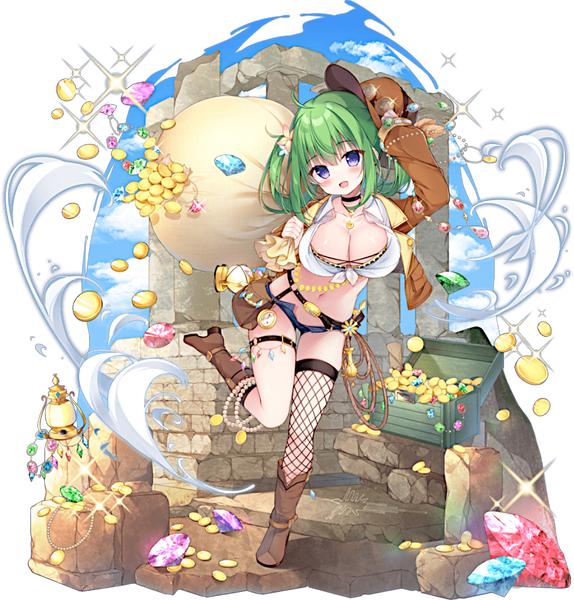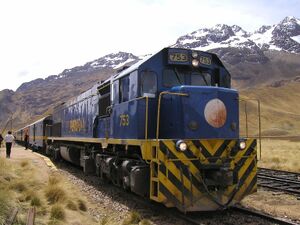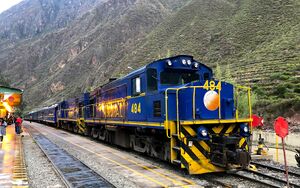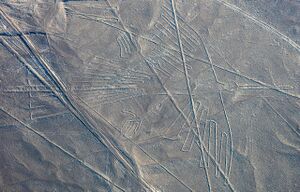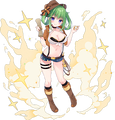Nazca
| Nazca | |||||
|---|---|---|---|---|---|
| Japanese Name | ナスカ | ||||
| Weapon | |||||
| Race | Human | ||||
| Nationality | |||||
| Birthday | December 17 | ||||
| Constellation | Sagittarius | ||||
| Talents | Ability to transfer curses to others, and vice versa | ||||
| Likes | Juniors, Ruins (when they're destroyed), Chicha (corn liquor) | ||||
| Dislikes | Sand People, Water People, Literacy, Curses and grudges | ||||
| Strengths | Caring and friendly, Positive | ||||
| Weaknesses | Putting her own desires above important monuments and the will of the state | ||||
| Hobbies | Ball games, Sculpting | ||||
Señora Nazca here was born in Flamarine, during the time of the war between the Sand Peoples and the Water Peoples! There, I was implanted with an ancient weapon called the Eclipse, as part of the Sand People's experiments, and then something happened and I became a mural... I'M TIRED OF TALKING!!!!
Layers
| Icon | Title | Release Date | Where to Obtain |
|---|---|---|---|
| [Desire-Devoted Adventurer] Nazca | 2023 September 8 | [EXP Point Camp - Nazca] Event Reward | |
| [The Curse Manipulator] Nazca | 2023 September 31 | [That Time I Got Reincarnated as a Conductor of the SSS] Event Reward | |
| [Hunting at Weddings Too] Nazca | 2024 May 31 | [Let's Go! Penal Colony Honeymoon] Limited Gacha | |
| [Ruins-Destroying Treasure Hunter] Nazca | 2023 August 31 | [That Time I Got Reincarnated as a Conductor of the SSS] Pick Up Gacha, Premium Gacha |
Skills
Trivia
- Nazca's birthday is the date of registration of the Nazca lines as a world heritage site of UNESCO.
- Nazca's design is a direct homage to Indiana Jones. Peru is primarily featured in Indiana Jones and the Kingdom of the Crystal Skull. Notable examples include the Nazca Lines as a clue for Indiana Jones to find the Crystal Skull of Akator. When Mutt Williams brought the letter to Jones, he correctly identified the "lines only the Gods can read" as the Nazca Lines. Indiana Jones's whip is also iconic for his appearance.
- Chicha is a fermented (alcoholic) or non-fermented beverage of Latin America, emerging from the Andes and Amazonia regions. In both the pre- and post-Spanish conquest periods, corn beer (chicha de jora) made from a variety of maize landraces has been the most common form of chicha.
- A mini version of the hummingbird Nazca Line is visible in [Ruins-Destroying Treasure Hunter].
Counterpart
Rail transport in Peru has a varied history. Peruvian rail transport has never formed a true network, primarily comprising separate lines running inland from the coast and built according to freight need rather than passenger need. Many Peruvian railroad lines owe their origins to contracts granted to United States entrepreneurs Henry Meiggs and W. R. Grace and Company but the mountainous nature of Peru made expansion slow and much of the surviving mileage is of twentieth-century origin. It was also challenging to operate, especially in the age of the steam locomotive.
In the latter part of the 1880s, the principal public railways, the Central and Southern, with others, passed to the control of the Peruvian Corporation, registered in London and controlled by Americans Michael and William R. Grace. The Southern Railway, Ferrocarriles del Sur del Perú (FCS), another Meiggs concession, was completed from Arequipa to Puno in 1876 and to the coast at Matarani. The railway also operated steamers (including the Yavari) and train ferries on Lake Titicaca connecting with Guaqui in Bolivia. Although work on the Juliaca–Cuzco section was begun in 1872 it was not completed through until 1908. The summit of this section is reached at La Raya (4,313 m (14,150 ft) above sea level). Since 1999 it has been operated by PeruRail, an affiliate of the Belmond Ltd. group. These tourist trains form one of the luxury passenger services tourists can use in Peru. However, this survived as an operator only until 1999 when most surviving lines were privatized. Regular passenger traffic now operates over only a small proportion of the mileage.
On the route from Cusco to Machu Picchu, PeruRail transports the vast majority of visitors and provides several different services. The Belmond Hiram Bingham Pullman, named after Machu Picchu's American discoverer, Hiram Bingham, is the most expensive service. It departs from Poroy at 9 a.m., later than other departures. Meals, guides, bus service and entrance to the ruins are included. PeruRail's own lower category Pullman service with dining and observation/bar car resembling to Titicaca Train was introduced 2017 with the name Sacred Valley.
The luxury sleeper train, Belmond Andean Explorer is operated from Cusco for a one-night journey to Puno, and a two-night three-day journey to Arequipa. Its carriages were formerly used on the Great South Pacific Express in Australia between 1999 and 2003, and brought to Peru in February 2016. Until the inauguration of this service in May 2017, the name was featured by a first-class service day train, which was renamed to Titicaca Train. It has Pullman-style dining cars and an open-air observation bar car similar to Hiram Bingham. This service provides a 10-hour trip from Cusco to Puno. The interiors of its vehicles were designed by James Park & Associates, the same company who designed the elegant first-class cabins for Singapore Airlines. The actual work, however, was done in Cusco by Cusquenian workers. After the refurbishment was completed, a traditional Andean ceremony, 'Pago a la Tierra' (payment to Mother Earth), was organised to 'bless' the train. A local shaman presided over the ceremony, which involved many traditional rites. Wikipedia
The Nazca Lines are a group of geoglyphs made in the soil of the Nazca Desert in southern Peru. They were created between 500 BC and 500 AD by people making depressions or shallow incisions in the desert floor, removing pebbles and leaving different-colored dirt exposed. There are two major phases of the Nazca lines, Paracas phase, from 400 to 200 BC, and Nazca phase, from 200 BC to 500 AD. In the years leading up to 2020, between 80 and 100 new figures had been found with the use of drones, and archaeologists believe that there are more to be found.
Most lines run straight across the landscape, but there are also figurative designs of animals and plants. The combined length of all the lines is more than 1,300 km (800 mi), and the group covers an area of about 50 km2 (19 sq mi). The lines are typically 10 to 15 cm (4–6 in) deep. They were made by removing the top layer of reddish-brown iron oxide-coated pebbles to reveal a yellow-grey subsoil. The width of the lines varies considerably, but more than half are slightly more than 33 cm (13 in) wide. In some places they may be only 30 cm (12 in) wide, and in others reach 1.8 m (6 ft) wide.
Some of the Nazca lines form shapes that are best seen from the air (at around 500 m [1,600 ft]), although they are also visible from the surrounding foothills and other high places. The shapes are usually made from one continuous line. The largest ones are about 370 m (400 yd) long. Because of its isolation and the dry, windless, stable climate of the plateau, the lines have mostly been preserved naturally. Extremely rare changes in weather may temporarily alter the general designs. As of 2012, the lines are said to have been deteriorating because of an influx of squatters inhabiting the lands.
The figures vary in complexity. Hundreds are simple lines and geometric shapes; more than 70 are zoomorphic designs, including a hummingbird, spider, fish, condor, heron, monkey, lizard, dog, cat, and a human. Other shapes include trees and flowers. Scholars differ in interpreting the purpose of the designs, but in general, they ascribe religious significance to them. They were designated in 1994 as a UNESCO World Heritage Site. Wikipedia
Map
Gallery
- Pages using Tabber parser tag
- Pages using DynamicPageList3 parser tag
- Weapon Whip
- Human
- Flamarine
- Sagittarius
- Element Blow
- Element Wind
- Element Dark
- Metro Train Knights
- Peru

